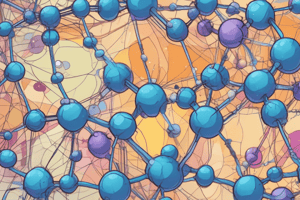Podcast
Questions and Answers
What revolutionary theory did Alfred Werner develop?
What revolutionary theory did Alfred Werner develop?
The theory of coordination compounds.
In what years did Werner formulate his theory of coordination compounds?
In what years did Werner formulate his theory of coordination compounds?
From 1890 to 1893.
What is a coordination entity?
What is a coordination entity?
A coordination entity consists of a central metal atom or ion bonded to a fixed number of ions or molecules.
Who was the first Swiss chemist to win the Nobel Prize, and for what work?
Who was the first Swiss chemist to win the Nobel Prize, and for what work?
What is referred to as the central atom or ion in a coordination entity?
What is referred to as the central atom or ion in a coordination entity?
Give an example of a coordination entity.
Give an example of a coordination entity.
What are ligands in the context of coordination compounds?
What are ligands in the context of coordination compounds?
What role do central atoms/ions play in coordination compounds?
What role do central atoms/ions play in coordination compounds?
How is the position of an abbreviated ligand determined in the alphabetical order?
How is the position of an abbreviated ligand determined in the alphabetical order?
What is the proper way to write the formula for a coordination entity?
What is the proper way to write the formula for a coordination entity?
What should you ensure when writing the formula of a charged coordination entity?
What should you ensure when writing the formula of a charged coordination entity?
In what order are ligands named when creating the names of coordination compounds?
In what order are ligands named when creating the names of coordination compounds?
What is the naming convention for anionic ligands in coordination compounds?
What is the naming convention for anionic ligands in coordination compounds?
Which ligands have special names instead of the usual naming conventions?
Which ligands have special names instead of the usual naming conventions?
What ensures there is no space between the ligands and the metal in a coordination sphere?
What ensures there is no space between the ligands and the metal in a coordination sphere?
How do you determine the charge balance in coordination entities?
How do you determine the charge balance in coordination entities?
What type of hybridisation occurs in a tetrahedral complex with four coordination numbers?
What type of hybridisation occurs in a tetrahedral complex with four coordination numbers?
Which hybridisation leads to a square planar geometry?
Which hybridisation leads to a square planar geometry?
Identify the hybridisation associated with a trigonal bipyramidal arrangement.
Identify the hybridisation associated with a trigonal bipyramidal arrangement.
What hybridisation corresponds to octahedral complexes?
What hybridisation corresponds to octahedral complexes?
How can the geometry of a complex be predicted?
How can the geometry of a complex be predicted?
What is the oxidation state of cobalt in the diamagnetic complex [Co(NH3)6]?
What is the oxidation state of cobalt in the diamagnetic complex [Co(NH3)6]?
What electron configuration does cobalt have in the complex [Co(NH3)6]3+?
What electron configuration does cobalt have in the complex [Co(NH3)6]3+?
Why is it significant for hybridised orbitals to overlap with ligand orbitals?
Why is it significant for hybridised orbitals to overlap with ligand orbitals?
Why is geometrical isomerism not possible in tetrahedral complexes?
Why is geometrical isomerism not possible in tetrahedral complexes?
What are optical isomers?
What are optical isomers?
What distinguishes dextro and laevo optical isomers?
What distinguishes dextro and laevo optical isomers?
In which type of complexes is optical isomerism more common?
In which type of complexes is optical isomerism more common?
What type of isomerism does the coordination entity [PtCl2(en)2] exhibit?
What type of isomerism does the coordination entity [PtCl2(en)2] exhibit?
How are chiral molecules related to optical isomerism?
How are chiral molecules related to optical isomerism?
Can tetrahedral complexes have optical isomers?
Can tetrahedral complexes have optical isomers?
What are the two forms of optical isomers based on their optical activity?
What are the two forms of optical isomers based on their optical activity?
What is the molar ratio of ethane-1,2-diamine to nickel(II) that produces the complex [Ni(H2O)4(en)]?
What is the molar ratio of ethane-1,2-diamine to nickel(II) that produces the complex [Ni(H2O)4(en)]?
What color change occurs when [Ni(H2O)6]2+ reacts with ethane-1,2-diamine?
What color change occurs when [Ni(H2O)6]2+ reacts with ethane-1,2-diamine?
What is the final complex formed when excess ethane-1,2-diamine is added to [Ni(H2O)2(en)2]?
What is the final complex formed when excess ethane-1,2-diamine is added to [Ni(H2O)2(en)2]?
What is the apparent color of the complex [Ni(H2O)2(en)2]?
What is the apparent color of the complex [Ni(H2O)2(en)2]?
Which transition metal ion is responsible for the red color of ruby?
Which transition metal ion is responsible for the red color of ruby?
What characteristic does chromium(III) have in relation to its position in the alumina lattice of ruby?
What characteristic does chromium(III) have in relation to its position in the alumina lattice of ruby?
What mineral do chromium(III) ions occupy to form emerald?
What mineral do chromium(III) ions occupy to form emerald?
What type of transitions give rise to the colors observed in transition metal complexes?
What type of transitions give rise to the colors observed in transition metal complexes?
Flashcards are hidden until you start studying
Study Notes
Alfred Werner and Coordination Chemistry
- Alfred Werner developed the coordination theory in 1890-1893.
- Werner was the first Swiss chemist to win the Nobel Prize (1913) for his work.
Key Terms in Coordination Chemistry
- A coordination entity consists of a central metal atom or ion bonded to a fixed number of atoms, ions, or molecules.
- Example: [CoCl3(NH3)3]
- The central atom/ion is the atom/ion to which ligands are bound.
- Examples: Ni in [NiCl2(H2O)4], Co in [CoCl(NH3)5], Fe in [Fe(CN)6]
- Ligands are the ions or molecules bound to the central atom/ion.
- Examples: Cl-, H2O, NH3, H2NCH2CH2NH2, N(CH2CH2NH2)3, proteins
- The entire coordination entity's formula is enclosed in square brackets.
Naming Coordination Compounds
- Cation is named first.
- Ligands are named alphabetically, followed by the central atom/ion.
- Anionic ligands end in -o, while neutral and cationic ligands have the same name except for:
- aqua (H2O)
- ammine (NH3)
- carbonyl (CO)
- nitrosyl (NO)
Geometric Isomerism
- Tetrahedral complexes do not show geometric isomerism.
- The relative positions of the unidentate ligands are the same.
Optical Isomerism
- Optical isomers are non-superimposable mirror images, also called enantiomers.
- Chiral molecules or ions cannot be superimposed.
- Dextro (d) and laevo (l) forms rotate the plane of polarized light in a polarimeter.
- d rotates to the right.
- l rotates to the left.
- Optical isomerism is common in octahedral complexes with didentate ligands.
- Example: [Co(en)3]3+, where en = ethane-1,2-diamine
Valence Bond Theory and Hybridization
- Hybridization allows for the overlap of metal orbitals with ligand orbitals that can donate electron pairs.
- Coordination number and hybridization type determine the geometry:
- 4: sp3 (tetrahedral), dsp2 (square planar)
- 5: sp3d (trigonal bipyramidal)
- 6: sp3d2 (octahedral), d2sp3 (octahedral)
Examples of Coordination Compounds and their Properties
- [Co(NH3)6]3+:
- Octahedral geometry
- Diamagnetic
- Cobalt(III) ion has a 3d6 configuration.
- [Ni(H2O)6]2+, [Ni(H2O)4(en)]2+, [Ni(H2O)2(en)2]2+, [Ni(en)3]2+:
- Show a series of color changes as the number of ethane-1,2-diamine (en) ligands increases.
- Illustrate the effect of ligand exchange on color.
Color in Coordination Complexes
- The color of coordination complexes is due to electronic transitions within the d orbitals of the transition metal ion.
- Gemstones like ruby and emerald get their colors from the presence of transition metal ions in their crystal structures.
- Ruby: Al2O3 with Cr3+ ions.
- Emerald: Be3Al2Si6O18 with Cr3+ ions.
Studying That Suits You
Use AI to generate personalized quizzes and flashcards to suit your learning preferences.




